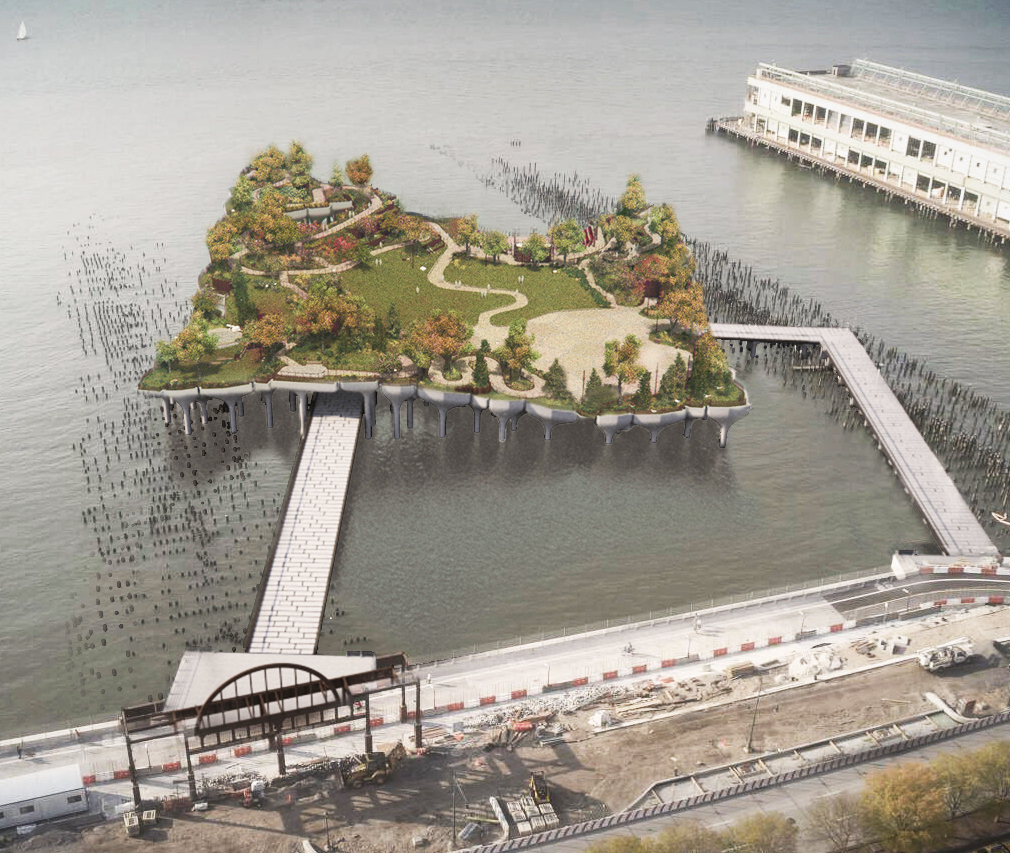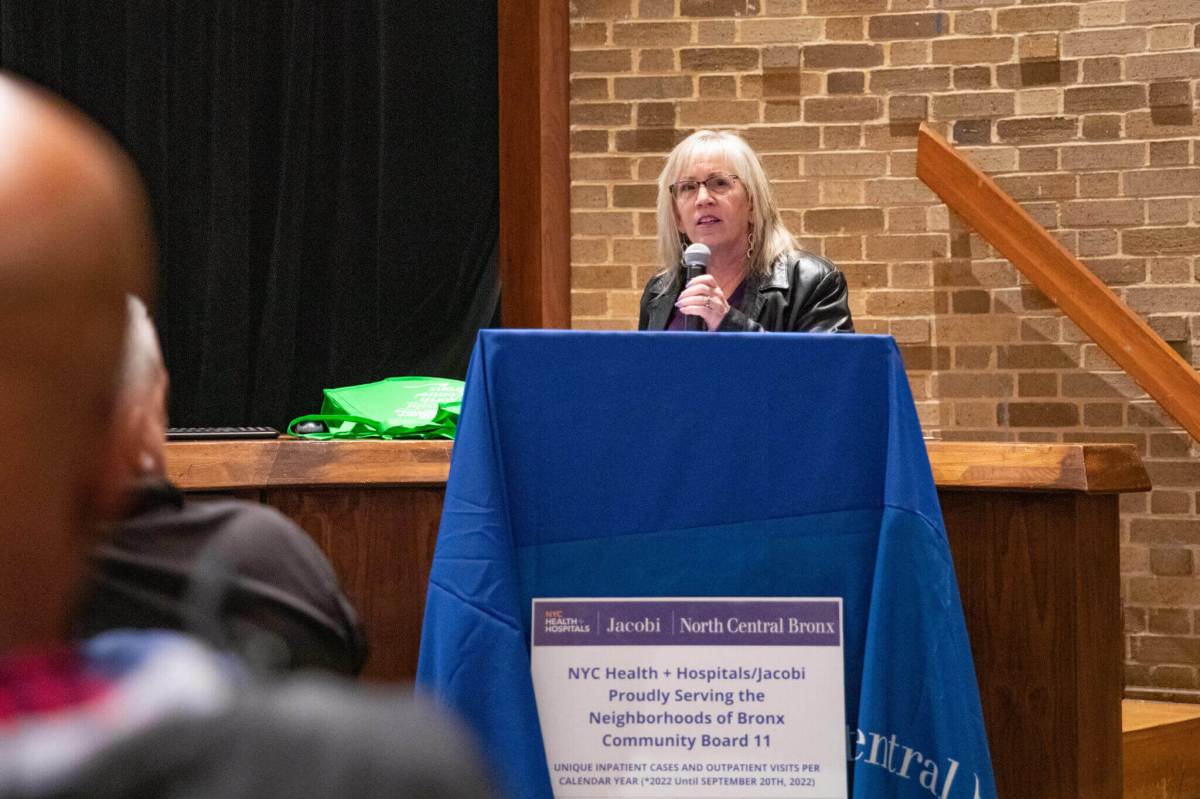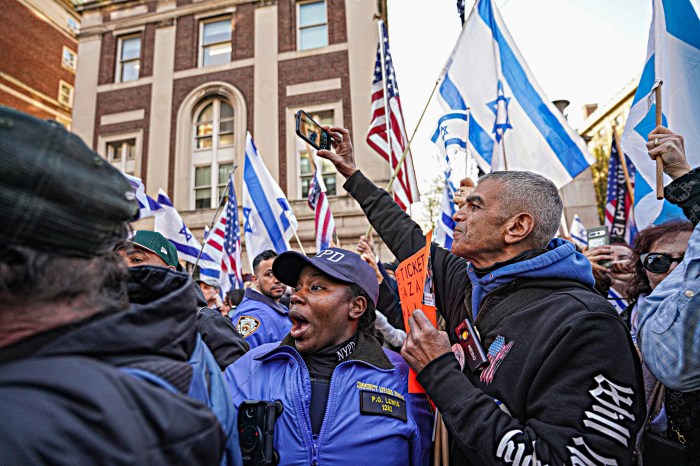
BY LINCOLN ANDERSON | Last Friday, The City Club of New York and two of its members who are leading waterfront activists — Tom Fox and Rob Buchanan — filed a new lawsuit in federal court against Barry Diller’s ambitious $250 million Pier55 project on the Greenwich Village waterfront.
This Monday, the plaintiffs met with representatives of media mogul Diller and the Hudson River Park Trust to see if a solution can be worked out under which the high-profile “arts pier” can proceed.
As envisioned by its supporters, Pier55 would sit offshore at W. 13th St. and be connected to the mainland by two narrow pedestrian bridges. The 2.7-acre pier would sport an undulating, foliage-covered landscape, plus three performance spaces that would host numerous performances that would be a mix of free and ticketed. In what would be a gift to a public park of historic proportions, Diller would fund most of the project’s construction cost, plus program the pier’s performance spaces and fund the pier’s ongoing maintenance through a nonprofit group, Pier55 Inc.
The project’s supporters laud Pier55 as an opportunity or an incredible public / private partnership. Meanwhile, its opponents deride the grandiose scheme, mockingly referring to it as “Diller Island” and “Dilligan’s Island.”
In their newest lawsuit, the plaintiffs charge that an alleged “permit modification” for Pier55 that the U.S. Army Corps of Engineers issued last month to the Trust — the Hudson River Park’s governing state/city authority — after some tweaks were made to the pier’s design is invalid because the Corps instead must issue a completely new permit for the plan, which would, in turn, necessarily involve a whole new public review process.
Setting the stage for the current situation, in March, in a stunning decision on the first lawsuit, federal judge Lorna Schofield ruled for the City Club plaintiffs and rescinded the Army Corps’ previous permit for the project. In a strongly worded decision, Schofield said the Corps’ determination that the basic use of Pier55 was “water dependent” was wrong and a violation of the federal Clean Water Act. Pier55 would essentially be used for performances and recreation — but not fishing, boating or swimming or any other water-based uses — so there’s obviously no reason it needs to be on the water, the judge said.
Last month, with the news that the “permit modification” had been issued for the slightly redesigned Pier55, Mayor Bill de Blasio, Governor Mario Cuomo and U.S. Senator Chuck Schumer all issued enthusiastic statements urging that the glitzy billionaire-backed project be allowed to go forward.
Then, last week, The New York Times reported that de Blasio had personally reached out to Douglas Durst — the wealthy developer and former chairperson of the Friends of Hudson River Park — phoning him to ask that he drop his financial support for The City Club’s lawsuits against the project.
Durst had long been suspected of funding the lawsuits, but there had never been proof — that is, not until The Villager, in May, got Durst to admit on the record that he had, in fact, financially backed the litigation.
The Villager’s big scoop came about after Michael Novogratz, the current chairperson of the Friends of Hudson River Park — the 5-mile-long park’s leading private fundraising group — during a lengthy interview, repeatedly told the newspaper he was certain Durst was funding the court challenges.
“It feels like a conspiracy,” Novogratz said then, “by funding by Durst and a group of old guys [The City Club plaintiffs] who still want to seem relevant. Durst seems obsessed with the park.” Novogratz has slammed The City Club plaintiffs as a group with “crusty, petty grievances” while calling Durst “not very patriotic” for fighting the Pier55 plan.
Fox, in turn — who prefers to refer to himself as an “old lion” — back then told The Villager to just call up Durst and ask him, and, yes, Durst finally admitted that he had financed the suits — though he declined to say exactly how much money he had given. As for why Durst had been keeping a low profile, the developer said, “The reason I did not want my name involved is I did not want this to be a personal battle between me and Barry Diller.”
Fast-forward to this Monday’s meeting. Fox said he couldn’t talk about it in great detail due to the fact that it’s now an ongoing negotiation, and that the parties are hoping to work things out, but he did give a general sense of the effort’s goals.
“We met yesterday, and we’re going to meet next week,” he said. “I’m not at liberty to discuss [specifics]. We’re looking at ways to mitigate our concerns about Pier55 — and they’re listening. We presented a series of suggestions, and they’ll come back next week and let us know what they think of them.”
A veteran waterfront park activist, Fox led the Hudson River Park Conservancy, the Trust’s predecessor, and was intimately involved in the West Side riverfront park’s early planning. He was also a former board member of the Friends. He and Durst both had a falling out with the Trust’s leadership and left the Friends in 2012.
Fox said neither Diller nor Novogratz were at Monday’s meeting with the Trust and Diller reps, and he declined to get into details on who was there.
“There were 10 of them and seven of us,” was all he would say. “It was a chance to change pace. We actually met with principals.”
He said the Trust reached out to them before they filed the new lawsuit last Friday. Whether the fact that they were going to file the suit prompted the meeting, he said he could not say.
“We’re hoping to see if we can find some common ground,” Fox stressed.
In a nutshell, he said, describing The City Club’s position, “This permit is a new permit because the old permit was vacated. It can’t be a modification of a permit that was thrown out [by Judge Schofield].”
In short, the lawsuit charges that the Trust and Diller now need to “go back to scratch with public hearings” for the project.
Fox, Buchanan — who builds and rows traditional Whitehall boats — and the club have two main beefs against Pier55: first, that the plan was hatched in secret and that there was “no transparency” to the process; and, second, that the Trust failed to do an in-depth environmental impact study for the project.
The Trust contends it did adequate public outreach and review for the Pier55 plan.
The Trust previously did a lower-bore environmental assessment for rebuilding Pier 54, and then used that study for Pier55. The Trust subsequently ripped the crumbling concrete decking off Pier 54 — its former primary performance pier — and focused its energies on building Pier55 in a totally new footprint between the old wooden-pile fields of Piers 54 and 56.
“Our pretense is that this is a new project — not a reconstruction of Pier 54,” Fox asserted.
Furthermore, the Trust’s recent modifications of the Pier55 plan would affect the impact that the project, if built, would have on the surrounding area, the activist maintained.
“With the modification of the permit,” Fox noted, “they said they can’t have trees on the island because there’s not enough carrying capacity [on the pier]. They had said trees would mitigate the noise from the pier — but there are no trees on the island now. … They’re going from poured concrete [in the tops of the piles] to driven piles.”
The project’s earlier “pot”-style support piles — with mushroom-shaped tops — would have allowed areas for trees to root, but the traditional driven piles which would now be used instead — which would not have poured concrete for their tops — would not be able to accommodate trees, according to Fox.
It was precisely this poured-concrete technique that was problematic under the Clean Water Act, Schofield had ruled, since this “flowable concrete” represented “fill” that could have impacted the Hudson River estuarine sanctuary.
The Corps’ new so-called “modified permit” was granted after the Trust removed these special “pot” piles calling for flowable concrete to be poured anywhere where they appeared from the waterline and below.
But now Fox is hoping that the two sides can come to an agreement.
“[The hope is] to see if everyone sitting at the table can do something that’s in the public interest,” he said. “Right now, we’re working together. We’re hopeful that we can reach common ground and that our concerns will be ameliorated.
“It’s good to be working with people instead of against people for a change,” he said. “I’m sure both sides think it’s better to be working together. It’s apparent that they’d like to move the project forward — and that’s the way compromises are reached.”
A Trust spokesperson said the authority hopes to restart construction on Pier 55 in “mid-August.” Fox said his understanding is the Trust wants to start Aug. 15. Currently, all that has been built is a small deck overhang along the bulkhead — the Manhattan seawall — off of W. 13th St. and some pile supports for one of the bridges that would extend to the island, which if the island never does get built, would no doubt be dubbed “a bridge to nowhere.”
Another Trust spokesperson offered a comment on the latest lawsuit and the negotiations with The City Club.
“While we believe these new claims to be without merit,” he said, “we look forward to working toward a constructive resolution in the near future.”
Meanwhile, Novogratz, a high-powered financial tycoon used to winning, is still steamed at The City Club and Fox and Co., yet hoping for the best.
In a statement this week, Novogratz said, “It’s remarkable that the Trust has to negotiate with people who in no way represent the views of the community. But I hope they can make some progress, because the neighborhood, and New Yorkers, want this park built.”
Meanwhile, though negotiations are now underway, after its filing last Friday, The City Club’s latest lawsuit is active.
The suit’s preliminary statement starts by declaring, “The Hudson River Park Trust’s end run around the Clean Water Act — and around this Court — must fail.”
The suit charges that the Trust, “rather than try to justify why it insists upon building a quasi-private performance venue in a protected Estuarine Sanctuary…sought to avoid the need for a [Clean Water Act] permit by redesigning the project. Without any notice to the public, the Corps again acquiesced and issued a new permit modification. … The new permit modification…is unlawful. … The barrier to non-water-dependent construction in a special aquatic site is meant to protect environmentally sensitive waters by discouraging unnecessary development that does not need to be located in the water.”
In addition, the suit states, a section — Special Condition D — of the permit that the Corps issued to the Trust in 2000 for the construction of the entire Hudson River Park, in general, forbids any increase in the “historic load-bearing capacity of any piers to be repaired or reconstructed [and] is designed to shield the environmentally sensitive Hudson River from unnecessary in-water development. … The purpose of Special Condition D, according to the Corps, is to limit the scale of development on the piers and along the waterfront.”
The implication is that Pier55 would have a higher load-bearing capacity than the old Pier 54.
“Compliance with Special Condition D is mandatory,” the plaintiffs state, “and this project is precisely the kind of activity Special Condition D was designed to stop by limiting capacity to avoid ‘large-scale development on the piers and along the waterfront.’ The Corps’ clear failure to consider Special Condition D makes the permit modification unlawful.
“Furthermore, [the Trust] can only obtain a permit modification if there is a valid permit,” the lawsuit’s preliminary statement continues. “But there is none. … Because there is no valid permit to modify, the Corps was required to review [the Trust’s] application as an application for a new permit — which requires public notice, an opportunity for public comment and a public hearing.”

















